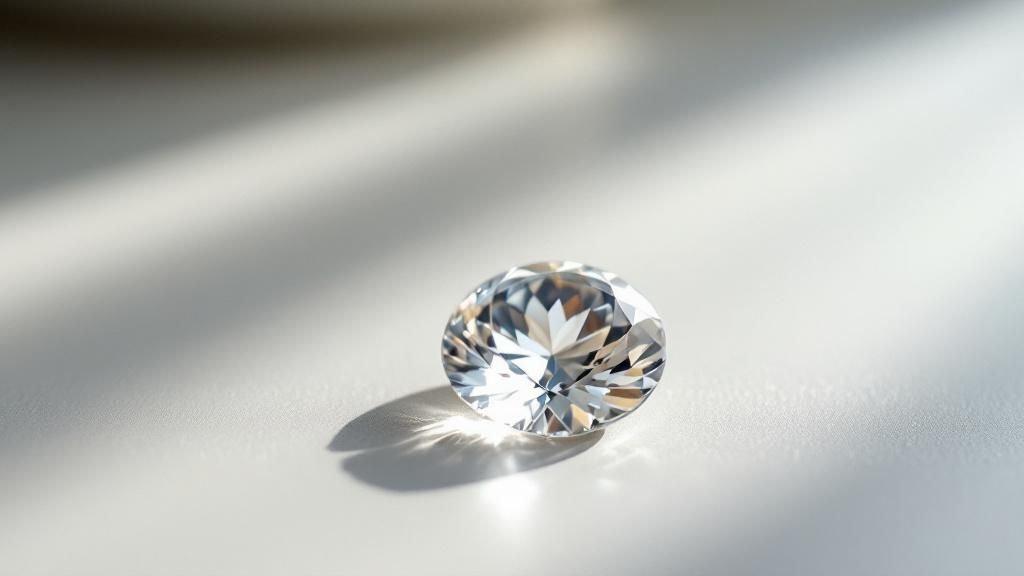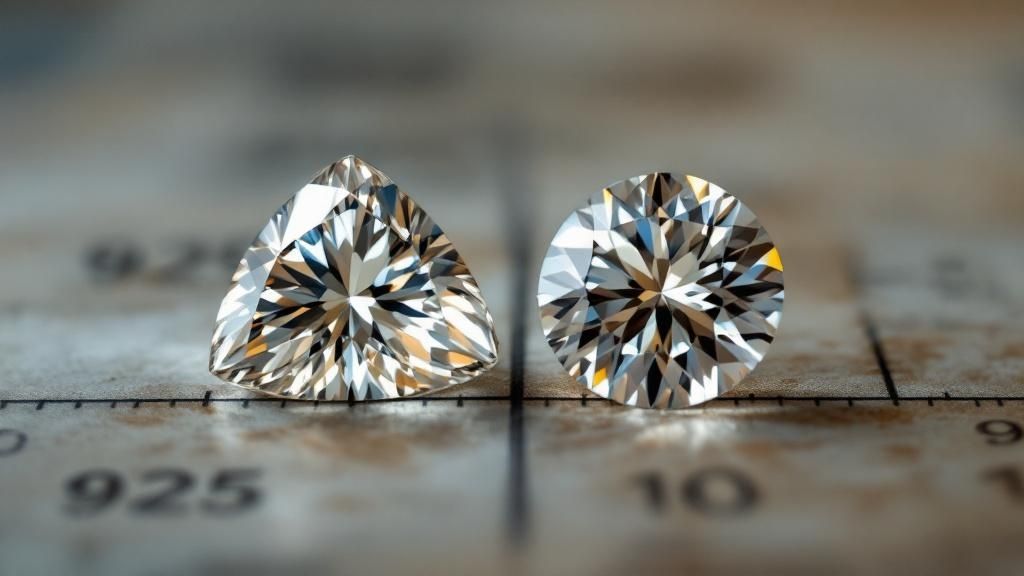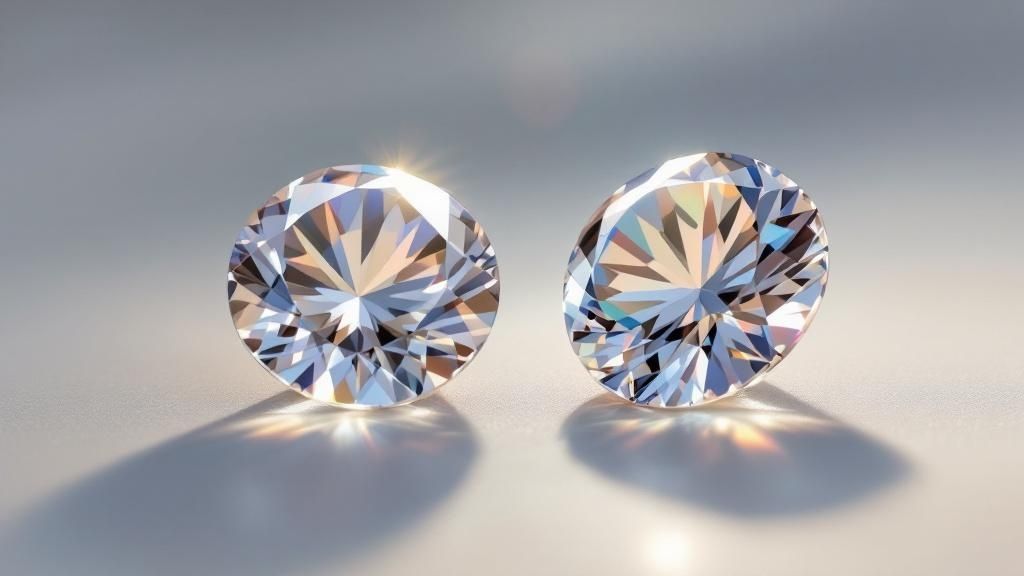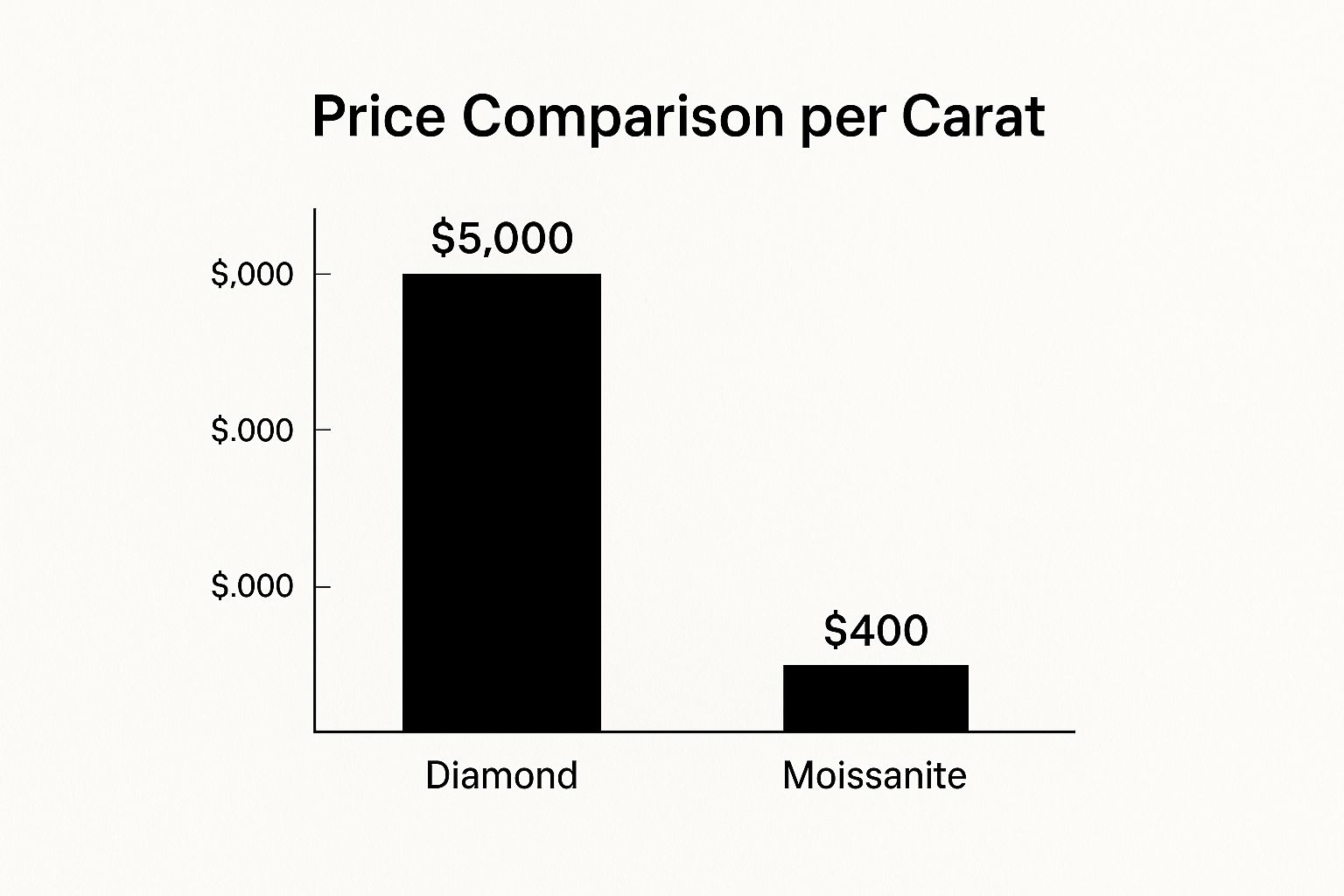What Is Moissanite vs Diamond? Your Ultimate Guide to Choosing
- Luke Zucco
- Aug 2
- 15 min read
When you’re weighing moissanite against a diamond, you're looking at two stones that seem incredibly similar at first glance but are worlds apart in their story and substance. A diamond is pure carbon, forged deep within the Earth over billions of years—it’s the classic, timeless symbol of love and rarity. Moissanite, on the other hand, is a stunning gemstone made of silicon carbide, almost exclusively created in a lab.
While your eye might not immediately tell them apart, their chemical makeup, how they handle light, and their price tags are fundamentally different.
Moissanite vs. Diamond: An Executive Summary
Choosing between these two beautiful gems doesn't have to be complicated. Once you get a handle on their key traits, the right choice for you often becomes clear. Diamonds have a legacy built on their natural origin and incredible hardness, making them the most durable mineral known to man. This natural rarity and history are a huge part of their appeal—and their cost.
Moissanite has a more cosmic origin story. It was first found in a meteor crater by French scientist Henri Moissan, but natural moissanite is so scarce it's not used in jewelry. The moissanite you can buy today is meticulously grown in a controlled lab environment. This makes it a fantastic ethical and sustainable option, and it comes at a much friendlier price point than a diamond of the same size.

To really simplify things, let's break down what truly sets these two apart.
Moissanite vs Diamond Key Differences at a Glance
For a quick side-by-side, this table lays out the most important distinctions. It’s a great way to see exactly where each stone shines.
Attribute | Moissanite | Diamond |
|---|---|---|
Composition | Silicon Carbide (SiC) | Pure Carbon (C) |
Hardness (Mohs Scale) | 9.25 (Extremely tough) | 10 (The hardest natural mineral) |
Sparkle | Intense, fiery rainbow flashes | Crisp, balanced white light and fire |
Price | Significantly lower per carat | Premium price based on the 4Cs |
Origin | Lab-created | Mined or lab-grown |
Ethics & Sustainability | Always conflict-free and sustainable | Requires certification to ensure it's conflict-free |
Ultimately, the best choice really boils down to what you value most. If you're drawn to tradition, natural history, and a classic sparkle, a diamond is an unbeatable choice. But if you're looking for breathtaking brilliance, a more approachable price, and a guarantee of ethical sourcing, moissanite is an incredible modern alternative. Both are beautiful, durable gems that will last a lifetime.
Where Do They Come From? A Tale of Two Stones
To really get to the heart of the moissanite vs. diamond debate, you have to look at their origin stories. One is a product of our planet’s ancient history, while the other literally fell from the stars. These vastly different beginnings are often what tip the scales for buyers.
A natural diamond is one of Earth’s most remarkable creations. Formed over billions of years, deep within the planet's mantle, these gems are the result of pure carbon atoms being subjected to incredible heat and pressure. The process crystallizes the carbon into the iconic structure we all recognize.
Ancient volcanic eruptions carried these formations closer to the surface. Getting them out of the ground is a massive undertaking, and the mining process has significant environmental and social implications. This natural scarcity, combined with the difficult journey from deep earth to fine jewelry, is a huge part of a diamond's prestige and price tag. If you value that timeless tradition and natural origin, exploring a classic collection of diamond jewelry is a great way to see the benchmark for beauty and value.
Moissanite: A Gem Born from a Meteorite
The story behind moissanite is truly out of this world. It started back in 1893 when a French scientist, Dr. Henri Moissan, was examining mineral samples from a meteorite crater in Arizona. He found tiny, brilliant crystals he first mistook for diamonds. Upon closer inspection, he realized he'd discovered something completely new: a mineral made of silicon carbide (SiC).
This amazing find was named "moissanite" in his honor. Because natural moissanite is unbelievably rare, nearly all the moissanite you see in jewelry today is created in a laboratory.
This distinction is key. The moissanite you can buy isn't mined from the earth. Instead, it's carefully grown in a controlled lab setting that mimics the conditions needed for silicon carbide crystals to form. The result is a gemstone that's chemically and optically the same as the original, star-born version.
Sustainability and Ethics: A Clear Divide
How these stones are sourced creates a major difference in their ethical and environmental impact. Because moissanite is made in a lab, it completely bypasses the problems often linked to traditional diamond mining.
By being grown in a controlled environment, moissanite is inherently conflict-free and has a significantly smaller environmental footprint. For shoppers who put a high value on sustainability and ethical sourcing, this makes moissanite an incredibly compelling choice.
This controlled creation process offers a few clear benefits:
Guaranteed Conflict-Free: There’s no such thing as a "blood moissanite." Every single stone can be traced back to its lab, wiping out any worries about financing conflict.
A Smaller Environmental Footprint: Creating gems in a lab avoids the massive land disruption, water consumption, and carbon emissions that come with large-scale mining.
Flawless Quality: The lab environment allows for the creation of stones with exceptional clarity and color, free from the natural inclusions you might find in mined gems.
In the end, choosing between a gem forged by the Earth and one perfected by science is a personal call. A diamond connects you to ancient, natural forces, while moissanite represents a modern, sustainable alternative with its own fascinating story rooted in cosmic discovery.
Comparing Brilliance, Fire, and Overall Sparkle

If you place a moissanite and a diamond next to each other, the first thing you'll notice is the sparkle. It’s what draws us to these gems. But the way each one handles light is fundamentally different, creating a unique personality for each stone. Getting to know these differences is the key to figuring out which one you’ll love seeing on your hand every day.
The visual magic of any gemstone really comes down to two things: brilliance and fire. People often lump them together as "sparkle," but they are distinct optical effects that define a gem's character.
The Science of Sparkle Explained
Brilliance is all about the white light a gem reflects back to you. Think of it as pure, crisp brightness. A stone with high brilliance looks almost electric, returning light with incredible efficiency instead of letting it leak out the back.
Fire, on the other hand, is the colorful flash you see. When white light enters the gem, it gets split apart into a rainbow of spectral colors. This dispersion is what gives a stone its fiery, vibrant personality.
A diamond is famous for its perfect harmony of both. It delivers that dazzling, crisp white light (brilliance) but complements it with beautiful, controlled flashes of color (fire). It's this classic, elegant combination that has made diamonds the go-to for generations.
Moissanite’s most defining trait is its jaw-dropping fire. With a refractive index of 2.65-2.69 compared to a diamond's 2.42, moissanite bends light far more aggressively. The result is an intense "disco ball" effect—a shower of vibrant, fiery rainbow flashes.
This difference in light performance is probably the single biggest giveaway when comparing moissanite and diamonds. A moissanite almost always looks more colorful and fiery, especially in the right lighting, while a diamond's sparkle leans more heavily on that clean, white light return.
How Each Stone Performs in Different Lighting
The look of your stone can change dramatically depending on where you are. A gem's distinct properties can either pop or become more subtle based on the light source, which is a big deal for a piece you'll wear everywhere.
Let’s walk through a few real-world examples:
Under Direct Sunlight: This is moissanite’s time to shine, literally. The intense, full-spectrum light from the sun sets off its double-refractive nature, creating a dazzling display of rainbow fire that’s impossible to miss. A diamond will also look spectacular, but its sparkle will be more of a sharp, white glint with hints of color.
In-Office or Ambient Indoor Lighting: In softer, more diffuse light, the differences aren't as stark. A diamond's superior brilliance often gives it an edge here, making it look incredibly bright and white. A high-quality moissanite will still be beautiful and sparkly, but its signature fire might be a bit more toned down.
Dim, Romantic Lighting (like a candlelit dinner): In low-light settings, both stones do a great job of catching whatever light is available. A diamond’s sparkle tends to look like tiny, distinct camera flashes. Moissanite’s fire can create a colorful, mesmerizing glimmer that many find incredibly romantic and eye-catching.
Here’s a simple table to sum it up:
Lighting Condition | Moissanite's Appearance | Diamond's Appearance |
|---|---|---|
Direct Sun | Intense, fiery rainbow flashes | Balanced white light and strong sparkle |
Indoor Ambient | Bright with noticeable sparkle | Exceptionally crisp and white |
Low Light | Colorful, shimmering glimmers | Sharp, distinct flashes of light |
Considering Color Nuances
Beyond sparkle, the stone's body color is another factor. For years, older-generation moissanite was known for having a slight yellow or greenish tint. Thankfully, modern production has all but solved this problem.
Today's premium moissanite is sold as "colorless," easily rivaling the D-E-F color grades of top-tier diamonds. Even so, someone with a very keen eye might occasionally detect a subtle grayish or warm undertone in certain lights, especially when it’s right next to a flawless, colorless diamond. For most of us, this difference is practically invisible.
Ultimately, the choice comes down to personal taste. Are you drawn to the explosive, colorful fire of a moissanite, or do you prefer the classic, balanced brilliance of a diamond? There’s no right or wrong answer—only what you find most beautiful.
A Practical Look at Durability and Hardness

When you’re choosing a stone for something you’ll wear every single day, like an engagement ring, you need to know it can handle real life. This is where the practical side of the moissanite vs. diamond debate gets interesting. Both are incredibly tough, but there are some key differences that matter.
A gemstone's ability to resist scratches is graded on the Mohs scale of hardness. We all know diamonds are famous for scoring a perfect 10, which makes them the hardest natural mineral on the planet. Put simply, only another diamond is going to scratch it. That’s why they’re the gold standard for heirloom-quality jewelry.
Moissanite, however, is no slouch. It clocks in at a 9.25 on the Mohs scale, which is seriously impressive. That puts it ahead of other tough gems like sapphire and ruby, making it one of the most durable choices available for jewelry. For all practical purposes, a moissanite is more than capable of standing up to the rigors of daily life without getting scratched up.
Hardness vs. Toughness: What This Means for Your Ring
Here’s a distinction that often gets overlooked: hardness isn't the same as toughness. Hardness is about resisting surface scratches, while toughness is about resisting chips and fractures from impact. Think of it this way: glass is quite hard, but it shatters easily, so it's not very tough.
Both diamonds and moissanite are exceptionally tough stones, but it’s important to remember that neither is invincible. A hard, direct hit at just the right angle can cause a chip or fracture in either gem.
The bottom line is this: Both moissanite and diamond are more than durable enough for an engagement ring you’ll wear every day. While a diamond technically wins on hardness, moissanite’s 9.25 rating ensures it will hold up beautifully against daily wear and tear.
This level of durability means you can wear a moissanite with confidence for years to come. You won't have to worry about it losing its luster or getting damaged from the occasional knock against a countertop.
Durability in the Real World
Let's translate these numbers into everyday scenarios your ring might face. How does this all play out in practice?
Accidental Knocks and Scrapes: Ever accidentally brushed your hand against a brick wall or a metal door frame? A diamond will come out of that encounter without a mark. A moissanite will almost certainly be fine, too, since very few everyday materials are hard enough to leave a scratch on it.
Cleaning and Chemicals: Both stones are incredibly stable and won't be harmed by common household chemicals. You can clean them with simple soap and water without fear of clouding or damage.
Long-Term Sparkle: The biggest threat to a gem's sparkle over decades is tiny surface abrasions that dull its finish. Because both moissanite and diamond are so high on the Mohs scale, they will keep their brilliant, fiery look for a lifetime.
Ultimately, when it comes to durability, the choice between moissanite and diamond isn't really about one being "good" and the other being "bad." Both are top-tier, reliable options. The slight difference in their Mohs rating is more of an academic point than a practical one for most people. Choosing moissanite doesn't mean you're compromising on durability; you're simply selecting an incredibly resilient and beautiful gemstone that is built to last.
Analyzing Cost, Affordability, and Long-Term Value
Let's be honest: when you’re comparing moissanite and diamonds, the most significant—and often the deciding—factor is the price. It’s more than just saying "moissanite is cheaper." You have to understand why that price gap exists and what "value" really means to you. This is where you make a choice that fits both your budget and what you want in a stone for the long haul.
The difference in cost comes down to their origins. Natural diamonds are expensive to find and bring to market. The process involves massive investments in exploration, heavy equipment, labor, and navigating a notoriously complex supply chain. All of that is baked into the final price tag you see at the jeweler.
Moissanite, on the other hand, is born in a lab. It sidesteps all those geological and logistical hurdles. Creating a large, flawless moissanite crystal is a controlled, technological process, making it far more efficient and less costly than pulling a similar diamond out of the earth. Those savings are passed directly to you.
The Price Gap in Real Numbers
To really see what this means for your wallet, let’s look at a direct comparison. The difference in cost isn't just a few hundred dollars; it's a game-changer for your budget. You can get so much more stone for your money with moissanite, and the savings only get bigger as the carat size increases.

This chart gives you a clear picture of the price-per-carat difference. For the same budget, you could either get a modest diamond or a substantially larger moissanite. That also means you could free up funds for a more elaborate setting or other pieces of fine jewelry.
Cost Comparison: Moissanite vs. Diamond by Carat Size
The numbers truly speak for themselves. Here’s a quick breakdown showing how a high-quality moissanite stacks up against a similarly graded diamond (G Color, VS2 Clarity) at popular carat weights.
Carat Weight | Average Moissanite Price | Average Diamond Price (G Color, VS2 Clarity) | Approximate Savings |
|---|---|---|---|
1.0 Carat | $600 | $5,500 | ~89% |
1.5 Carat | $900 | $12,000 | ~92% |
2.0 Carat | $1,300 | $20,000 | ~93% |
3.0 Carat | $2,100 | $35,000+ | ~94% |
As you can see, the financial gulf is enormous. Choosing moissanite means that a stunning, sizable stone is well within reach, whereas a diamond of the same size would be a much more significant financial commitment.
What Does "Value" Mean for Your Investment?
This is where the conversation gets more personal. Diamonds have a well-established history as a store of value. While they aren’t an investment in the traditional sense, high-quality natural diamonds do hold a portion of their initial cost on the resale market. That potential for resale is a type of long-term value that moissanite generally doesn't offer.
But there’s another way to define value: value for money. This is where moissanite truly shines.
Choosing moissanite opens up a world of possibilities for your budget. Instead of dedicating your entire budget to a single, smaller diamond, you could:
Go Big: Choose a significantly larger moissanite that would be out of the question financially with a diamond.
Upgrade the Setting: Spend more on a custom or higher-quality setting in platinum or 18k gold.
Complete the Look: Use the savings to buy matching wedding bands or other beautiful accessories, like these 14k gold womens diamond bracelets.
This flexibility is a unique kind of value. It empowers you to create the exact piece of jewelry you've been dreaming of without making financial compromises. Ultimately, the decision comes down to your priorities. If you view the purchase as a financial asset and a potential heirloom, a diamond's resale history gives it an edge. But if your goal is to get the most beauty, size, and durability for your money, moissanite offers an unbeatable proposition.
How to Choose Between Moissanite and Diamond
So, how do you actually decide? The moissanite vs. diamond debate really comes down to what you value most. There's no single "right" answer here, just the one that feels right for your budget, your style, and your personal beliefs.
Instead of just listing pros and cons, let's look at this through the lens of real-world priorities. Once you align what's most important to you with what each stone delivers, the best choice usually becomes obvious.
Choose a Diamond for Tradition and Enduring Value
Picking a diamond is often about more than just the stone itself; it's about embracing tradition. For centuries, diamonds have symbolized unwavering love and commitment. They carry a historical weight and a sense of permanence that many people find incredibly powerful.
A diamond is likely your best bet if these points hit home for you:
You're Thinking About an Heirloom: If you dream of passing your jewelry down to future generations, a diamond is a solid choice. They have a long-established history of holding their value, making them a true legacy piece.
You Prefer a Classic, White Sparkle: You love that iconic, crisp diamond brilliance—a sophisticated mix of white light and subtle flashes of color. It's a timeless look that never goes out of style.
The Natural Origin Story Matters: The idea of wearing a gemstone that was formed billions of years ago, deep inside the Earth, feels special and significant to you.
For anyone who connects with these ideas, a diamond is the undeniable classic. Its natural origins and deep-rooted legacy create an emotional value that's hard to replicate.
Choose Moissanite for Maximum Brilliance and Modern Values
Moissanite is the frontrunner for a new way of thinking about fine jewelry. It’s for the person who wants incredible visual impact, guaranteed ethical sourcing, and fantastic value. Simply put, it's about getting more bling for your buck without compromise.
Moissanite is the clear winner if you find yourself nodding along to these statements:
You Want Size and Sparkle on a Budget: Your main goal is getting the biggest, most brilliant stone you can afford. Moissanite lets you go big with a show-stopping gem for a fraction of what a diamond of the same size would cost.
Ethical Sourcing is a Must: You need to know your stone is 100% conflict-free and has a minimal environmental footprint. Since all moissanite is created in a lab, it comes with total peace of mind.
You Love Intense, Fiery Sparkle: You're mesmerized by that famous moissanite "disco-ball" effect. It throws off a spectacular rainbow of colors that truly stands out from the crowd.
The rise of moissanite isn't just a fleeting trend. The market is projected to grow from $156.12 million in 2025 to $202.5 million by 2030. This isn't just about numbers; it shows a real shift in what people care about, moving toward luxury that is both ethical and attainable.
In the end, it all comes down to what "value" means to you. Whether you're pairing a stunning centerpiece with elegant 14k gold women's diamond chains or investing in the timeless story of a natural gem, both moissanite and diamond deliver their own kind of lasting beauty.
Frequently Asked Questions About Moissanite
Even after digging into the specifics, a few common questions always pop up when comparing moissanite and diamonds. Getting solid answers to these is the last step before you can make a choice you’ll love for years to come. Let's tackle the questions we hear most often from shoppers.
The big one is always: can someone tell it’s a moissanite just by looking? For the average person, the answer is a simple no. To an untrained eye, a well-cut moissanite and a diamond of similar quality are virtually indistinguishable.
A professional jeweler might be able to spot the difference, usually by noticing moissanite's famous "disco ball" effect—that fiery, rainbow sparkle is much more intense than a diamond's. But for everyday wear, the visual similarity is striking.
Does Moissanite Get Cloudy Over Time?
This is a persistent myth that needs busting. Absolutely not. A real moissanite will never get cloudy, change color, or lose its sparkle. Its impressive hardness (9.25 on the Mohs scale) and stable chemical structure make it incredibly resistant to grime and damage.
What people mistake for cloudiness is just a buildup of everyday stuff like lotion, soap, and skin oils on the surface. A quick clean with warm water and a soft brush will bring its brilliant shine right back. In fact, because it repels dirt so well, many find their moissanite stays cleaner and sparklier for longer between cleanings.
It's crucial to understand that moissanite isn't a "fake" diamond. It is a genuine gemstone with its own distinct chemical makeup (silicon carbide) and optical properties. Calling it fake is like calling a sapphire a "fake ruby" just because they're both colored gemstones.
Originally discovered in a meteorite crater, moissanite is its own unique mineral. It isn't trying to be a diamond—it's a stunning and durable alternative with its own set of fantastic qualities.
Is Moissanite a Good Investment?
That really depends on your definition of "investment." If you're talking strictly about financial resale value, a natural diamond tends to hold more of its original price. However, if your idea of value is getting the biggest, most beautiful, and most durable stone for your money, then moissanite is an incredible choice.
Think about its value from these angles:
Affordability: You can get a much larger and visually perfect stone for a tiny fraction of a diamond's cost.
Durability: It’s tough enough for everyday wear, meaning it will last a lifetime without chipping or losing its brilliance.
Ethical Assurance: Since all moissanite is made in a lab, you get a 100% conflict-free and eco-friendly stone, guaranteed.
The "investment" in moissanite is in the immediate and lasting beauty you get to enjoy, along with the peace of mind from a smart, ethical purchase. You’re investing in a gorgeous piece of jewelry you can wear proudly without the financial weight or ethical questions that can come with mined gems.
At Panther De Luxe Shop, we believe in giving you clear choices and complete transparency. Whether you prefer the classic allure of a diamond or the modern fire of a moissanite, our collections are carefully chosen to offer outstanding quality and value. Explore our stunning jewelry to find the perfect piece that tells your story at https://www.pantherdeluxe.com.

Comments